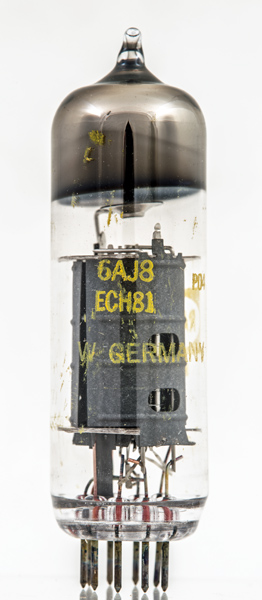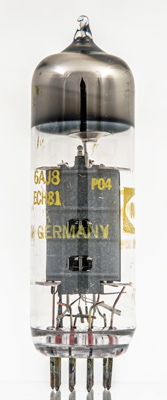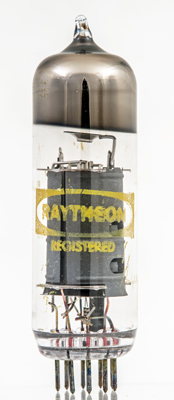|
6AJ8Sensibly equivalent¶ to:
|
|
|

|
The 6Aj8 (ECH81) triode heptode was designed in 1954 for the role of frequency changer (mixer) in superhet receivers for AM reception. The ECH81 acting as oscillator and mixer for AM and the heptode being the first IF amplifier on FM.The two valve sections share a common cathode. The triode is to be used as the local oscillator feeding the 13 Volts amplitude sine wave to the heptode mixer. Within the heptode, non linear operating causes the signals to interact to produce in the anode waveform the following major frequencies: signal, LO, signal + LO and signal minus LO. The anode circuit is tuned to enhance one of these signals, normally signal minus LO. For radio reception at the time an intermediate frequency of 455 KHz would be typical for AM.Raytheon made this valve in West Germany. The construction is of the triode mounted above the mixer and both are surrounded by the solid outer screen. The Cossor 6AJ8 has a perforated screen.
The open end of the screen with the heptode grids visible within. The lettering is printed on the glass.
The Raytheon Logo. On the right the holes in the screen reveal the straps connecting the two small anode plates.The thin glass tube envelope is 22 mm in diameter and, excluding the B9A base pins, is 70 mm tall.References: 4051 & 1040. Type 6AJ8 was first introduced in 1951. See also 1951 adverts. |
Pin Connections
| 1 | 2 | 3 | 4 | 5 | 6 | 7 | 8 | 9 |  g2,g4 | g1 | k,g5,s | h | h | a | g3 | a(t) | g1(t) |
|
|
Absolute Maximum Operating Conditions¶
| Vh | Ah | Va | mAa | 
| 6.3 | 0.3 | 100 | 13 |
|
Absolute Maximum Operating Conditions¶
| Va | Vs | Vg | mAa | mAs | ra | gm | 
| 250 | 250 | -2 | 6.5 | 3.8 | 0.7M | 0.775 |
|
Updated January 24, 2023.
|
|